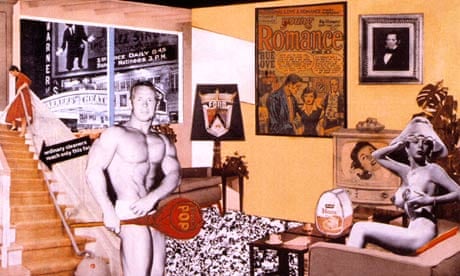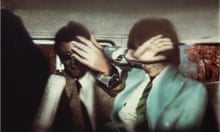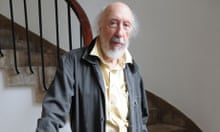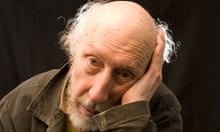In 1956 Richard Hamilton, who has died aged 89, attracted attention with his collaged poster image for the This Is Tomorrow exhibition at the Whitechapel gallery in London. It was quite shocking: a naked woman on a sofa and a bodybuilding he-man holding an oversized lollipop labelled "Pop" in a prominent position, lots of domestic gadgets including a TV, the cover of a comic presented as a framed painting, an all-too-urban scene through the landscape window, the ceiling covered with a space-age photo of Earth.
From then on he was referred to as the father of pop art, but celebrating lowbrow culture was never his aim. He did not share pop art's idolisation of advertisements and comic strips, nor the teenage dreams much of it referred to. His analysis of the methods of commercial and technical image-making was matched by his study of high art; when he quoted commercial images in his art they usually came from the top end of the market.
He was a member of the Independent Group of artists, architects and critics within the Institute of Contemporary Arts (ICA), who met to discuss popular culture as a then unregarded but vivid element in a seamless world of communication from which the fine arts might derive some strength. In 1978, the National Gallery invited him to assemble the second The Artist's Eye exhibition from its collection; Anthony Caro had done the first. The result was a purposeful confronting of fine old paintings and modern imagery, including My Marilyn (1965), his version of a sheet of contact prints marked up by the star, and a working, mute TV set.
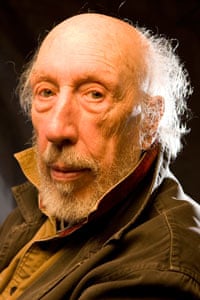
Hamilton later criticised the tendency of art schools to steer not by museum traditions but by "the current fashionable art scene". I think it was the lack of sheer intelligence going with this preference that horrified him. His own work benefited from both. In the 1960s the pop end sometimes dominated, as in the gigantic lapel-button he made in 1964 and exhibited as Epiphany, with "Slip It to Me" in blue and a finely judged orange ground. In the 1980s, most obviously when he was developing his two Northern Irish diptychs, The Citizen (1981-83) and The Subject (1988-90), he was working like an old master, using the best methods available. In the 1960s he wrote, "I have always been an old-style artist," and that remained his view of himself. He was a craftsman-artist, attending to his wide range of processes, but choosing them to reinforce and contribute to the meaning of his work. There was no room for nostalgia or thinking, but his ambition was to be up there with the best.
Hamilton was born in Pimlico, London, the son of Peter, a driver for a car showroom, and his wife, Constance. He attended art evening classes from the age of 12. When he was 13, he was advised to apply to the Royal Academy Schools at 16. When he got there, he had already seen Picasso's Guernica, and he admired Cézanne, both anathema at the RA. The Schools closed in 1940. Too young for conscription, Hamilton was sent to learn tool-making and engineering drawing, and then worked as a draughtsman, mostly for EMI.
In 1945 the Picasso and Matisse show of wartime paintings at the V&A thrilled him. In 1946 Hamilton was allowed to go back to his studies in the RA Schools, only to be thrown out for not bowing to RA priorities. There followed service in the Royal Engineers, but also a camouflage course, and time to read and reread James Joyce's Ulysses. He started making subtle and elegant illustrations to Ulysses, and returned to them throughout his life. The British Museum showed them in Imaging James Joyce's Ulysses (2002).
In 1948 William Coldstream accepted him to study painting at the Slade, and friendships spreading from there brought him into the ICA. D'Arcy Thompson's book On Growth and Form, published 30 years earlier, excited him with its evidence of mathematical growth patterns in nature. Hamilton devised and designed the Growth and Form exhibition shown at the ICA in 1951 and opened by Le Corbusier.
From 1952 until 1966, he taught at the Central School in London, alongside Victor Pasmore and others, and from 1953 on with Lawrence Gowing and Pasmore in the fine art department at King's College, Newcastle (later part of Newcastle University). It was Hamilton who inspired and organised the salvation and removal to the Hatton gallery at Newcastle University of Kurt Schwitters's last great work in progress, the so-called Merzbarn at Elterwater in the Lake District. He was ahead of his time: earlier this year, Schwitters was the presiding spirit at the RA's exhibition of modern British sculpture – the barn was built in replica in the courtyard before the entrance of Burlington House.
There, Hamilton started working on an English version of Marcel Duchamp's The Green Box with the art historian George Knox. This led to a friendship with Duchamp, a visit to America and, in 1966, he organised the first major Duchamp retrospective in Europe, The Almost Complete Works of Marcel Duchamp, shown by the Arts Council at the Tate gallery. It included Hamilton's approved facsimile of Duchamp's elaborately crafted The Large Glass of 1915-23, now in the Tate's collection.
The Duchamp exhibition heightened our interest in "anti-art", stemming from the international Dada movement of 1916. Coinciding with the enthronement of minimalism in New York as the latest in serious avant-gardery, the exhibition associated radical innovation with iconoclasm and mocked the rhetoric of abstract-expressionist splashed and slashed paints with its elaborate, even scholarly development of ideas and individual works. Hamilton was so much a Duchamp disciple that he had to "seek the opposite of his solutions". That meant, for instance, making works that are paintings, addressing eyes conditioned by art as well as the mind. Hamilton's paintings include several that comment on perception, and some that are pretty beyond belief until one finds the wrong note in them, and yet others in which he exploits commercial hard-sell symbolism and style in combination with fine-art devices. His analytical intelligence and insistence on the idea as a determining agent in his choice of techniques, as well as image, made him more a forerunner of conceptual than of pop art.
Hamilton was primarily a painter. His self-portrait Palindrome (1974) is at once modest and demanding: he shows himself reflected in a mirror towards which he leans rather as Artemisia Gentileschi leans towards her self-portrait canvas. That is, we see his hand on and in it, dabbing paint on it, and beyond it his own image; only the mirror plane, visible thanks to those dabs, is in sharp focus. As we look and move, we realise this is a 3-D photograph, planned and executed with care. Its visual complexity is matched by its implications about art and seeing, vanity and modesty, life and death.
His retrospective show at the Tate in 1970 culminated in his series of 12 "cosmetic studies" entitled Fashion-Plate, paying homage to magazine covers and the artifice behind them, but inviting thoughts about all icons. Many jabbed at its apparent celebration of fashion and the glibness of those glossy unportraits. Hamilton must have hated the shallowness of that kind of response. He wrote about his own work better than anyone, not to award it marks but to explain his methods and some of the thinking behind them. His collection of these texts was published in 1982 as Collected Words. Critics tend not to like artists who comment on their work that efficiently and entertainingly, but then these are very rare.
His second Tate retrospective was in 1992. It included the two triptychs about Northern Ireland. In 1987 he had appeared on television using the Quantel TV Paintbox to develop The Subject. Six artists were filmed using the Paintbox; he used it inventively and with ease. It was this sort of rootedness, as well as public disagreements about art education, that caused the critic Peter Fuller to denounce him as "the whore of art". The climax of the retrospective was a walk-through installation, Treatment Room (1983-84), reflecting his experience of x-ray theatres. In it was a table like a mortuary slab, over which a TV monitor played a tape of Margaret Thatcher giving her final party election broadcast in 1983.
British critics responded to the second retrospective negatively or even dismissively, but its 1993 version, in the British Pavilion at the Venice Biennale, won him the painting prize. Many had thought his presentation at the Biennale long overdue; it would have made a greater impact 10 or 20 years earlier. The difficulty centred on grasping his range: of aesthetic inquiries; of his industrial tools and processes; of his inherited techniques as painter, draughtsman and printmaker; and of visual expression, from the coolly erotic Hommage à Chrysler Corp (1957), a painted and collaged essay on styling, to the 1990 Polaroid self-portraits, taken through a glass screen touched with paint and with additional paint on the enlarged prints on canvas.
Sometimes he played with the cliches and the cliche-producing mechanics of the consumer society; at other times his attention went to the transforming power of photography and our conditioned reading of photographs, as in Whitley Bay (1965) and the series of studies derived from it; at yet others he used press and TV imagery to protest against various forms of oppression, including the media's free ways with facts when in pursuit of a "story". The Swingeing London 67 series commented on the supposed permissiveness of the 60s and the police's obligation to invade privacy. It was based on a newspaper photograph of Mick Jagger and the gallery owner Robert Fraser in a police van being brought to trial for smoking cannabis. Kent State (1970) was developed from a TV image of a student shot on campus by soldiers. War Games (1991-92) used TV news footage of the Gulf war to remind us that what the media delivered almost as a sport cost thousands of lives. Lobby (1984) derives from a postcard of a hotel entrance in Berlin, with its seemingly endless carpet and stairs and confounding mirrors. It reminded him of Sartre's Huis Clos; it also recalls Dante. The hotel is the Europa.
The young anti-Aristotelian, investigating rather than arbitrating, had been turned by life into one "only too prone to make value judgments", he said. His art was always looking outwards; he could admire, but could not be satisfied with, art referring only to itself. He was unusually full of ideas; he was passionately responsive to his time. But he also maintained that technology would never beat painting as a means of making art that matters.
Very British in many ways, not least his place in the tradition of Swift and Sterne, Hamilton was also seen as the most international of our artists, and in 2003 Museum Ludwig in Cologne held an Introspective work show organised in co-operation with Hamilton himself. He was made a Companion of Honour in 2000. In 2010 the Serpentine show Modern Moral Matters brought together his political works including Shock and Awe (2007-08).
In 1947, he married Terry O'Reilly, whom he had met at EMI. They had a daughter, Dominy, and a son, Roderic. Terry's accidental death in 1962 was a grievous blow to him. Subsequently Hamilton lived with the painter Rita Donagh; they worked independently but often side-by-side, and sometimes collaborated. They married in 1991. Hamilton is survived by Rita and Rod; Dominy predeceased him.
Richard Hamilton, artist, born 24 February 1922; died 13 September 2011
